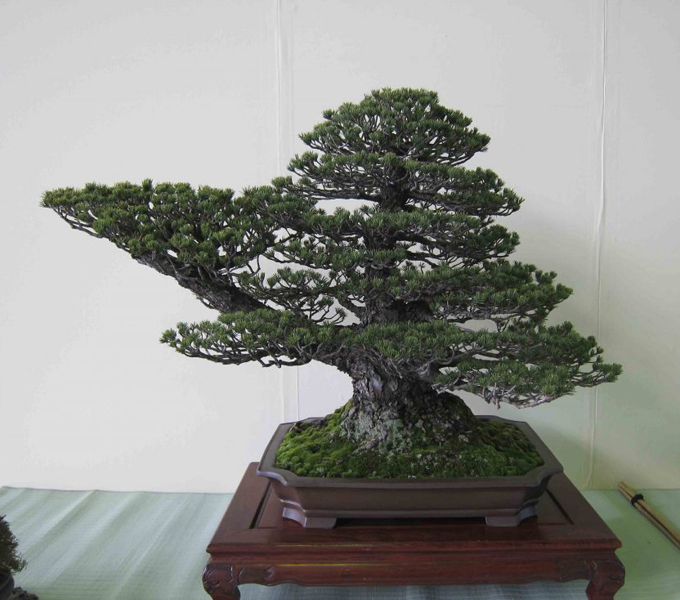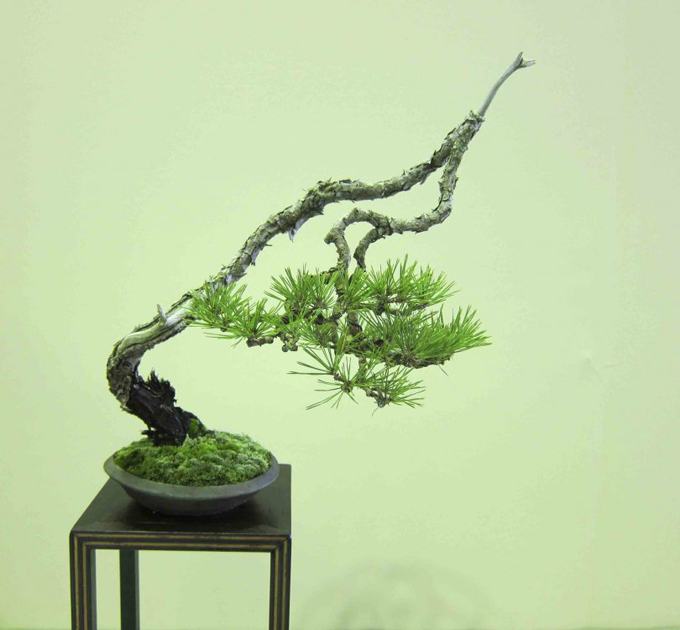
Caption from 2012: I don’t know if I’ve ever seen a bunjin style bonsai in such a deep pot. You almost always see them in shallow round or near-round pots. No problem though, this one works to perfection; a spectacular tree with a lustrous pot. I think the heavy foliage (unusual for a bunjin) helps balance the heavy pot (Message from 2014: I think it’s a stretch to call this tree a bunjin. Mostly because of the very robust foliage and the deep flashy pot. More below…).
It’s time to dig into our archives. This is one of our earlier Peter Tea posts, from January 2012. It’s titled, Eighty Two and Still Going Strong.
It occurs, from our sophisticated 2014 perspective, that you might question the bunjin creds of two of the trees shown here. Trees that we blithely referred to as bunjin at the time, without even a second thought. But those were more innocent days. Now, thanks to time and a little prompting from our friends, we might pause before we throw words like bunjin around (for more, you can check out the comments from the original post, one of which is copied at the bottom of this post).
Thanks again to Mr. Tea
The photos in this post are all courtesy of Peter Tea, our current favorite bonsai apprentice (nothing personal to the rest of our apprenti in Japan, it’s just that Peter keeps sending great stuff).
Meifu-ten, a show for hobbyists and collectors
It seems like most Japanese bonsai shows are for collectors and professionals, so it’s refreshing to see photos from a show that features collectors and hobbyists’ trees. Here’s some of what Peter has to say about the show: January 14-16 was the 82nd Annual Meifu-ten Bonsai show in Nagoya Japan. Meifu-ten is the second oldest show in Japan behind Kokufu-ten and this year exhibited over 170 trees. All the trees belong to hobbyists and collectors. The average attendance of for the three day show is about 7 thousand (Not too shabby!)…. here’s the rest.
7,000 per day!
In case you were wondering, bonsai is alive and well in Japan.
 A very distinctive Kokonoe Japanese white pine. I’ve seen other trees with dominant first branches that seem to break bonsai conventions. but this one really goes out on a limb (so to speak). And then there’s that extraordinarily powerful lower trunk.
A very distinctive Kokonoe Japanese white pine. I’ve seen other trees with dominant first branches that seem to break bonsai conventions. but this one really goes out on a limb (so to speak). And then there’s that extraordinarily powerful lower trunk.
 The original caption: Too sweet! It’s a Japanese red pine (in a traditional style bunjin pot). Updated now (2014): No doubt about this one’s bunjin credentials.
The original caption: Too sweet! It’s a Japanese red pine (in a traditional style bunjin pot). Updated now (2014): No doubt about this one’s bunjin credentials.
 It’s not that most of the trees in the show are bunjin, it’s just that we’ve got a soft spot for them. This one’s a Shimpaku juniper. All the deadwood action around the base (and perhaps another feature or two), makes for a very unusual bunjin. (2014: this is the other one).
It’s not that most of the trees in the show are bunjin, it’s just that we’ve got a soft spot for them. This one’s a Shimpaku juniper. All the deadwood action around the base (and perhaps another feature or two), makes for a very unusual bunjin. (2014: this is the other one).
“What you call a bunjin style doesn’t pass the test for me as bunjin.
You are right to call attention to the too deep pot.
It almost works, because the foliage mass is also sizable.
The pot is nice.
The twisted trunk is great.
The foliage mass is well groomed and looks great.
My problem with it is putting them all together.
The trunk is too thin to visually support the mass of the branches and foliage.
The trunk is too thin to visually support the mass of the pot.
I would love to have this bonsai and would scratch my head over how to solve the dilemma.
A pot about half the depth would solve half of the problem.
How to manage the other half without ruining the bonsai would be the harder problem to solve.”
Alan Walker, from the comments to the original post.
Quibble, quibble!
Worry less about whether it fits in some pigeon hole or the other than whether it’s beautiful and we like it….
These are beautiful, and I like them. End of story. Worrying at classification it for the armchair quarterbacks. And yes,the first one could have a more proper pot, which has nothing to do with classification and everything to do with composition.
As a scientist I can tell you that the harder you work at classification, the more elusive it gets.
Hi Wayne
I have to side with Terry on this topic.
Also on the other hand it would be more powerful in front of you & I think that all the huffing & puffing would go out the window.
Replaced with a large WOW / I wish that was mine?
JC from Downunder
Hi Terry, John too,
By now, nobody is reading this thread, so I can say what I would normally only say to my good friends and never put into print…. Yeah, yeah. Huffing and puffing. Though the old know-nothing argument has its moments, mostly it’s refuge for lazy people heavily invested in staying stuck in the same place for the rest of their lives. Not that I think this applies to either of you.
Since literati and by extension bunjin are styles that break the rules, it is hard to argue with the classification. the emphasis in both is trunk movement and line. Nebari is not the primary focus, nor is branch placement in perfect triads. These are break the rules, even bunjin rules, bujin or literati with plenty of cred.
And Terry, yes there are splitters and lumpers. And never the twain shall see eye to optic nerve.
bunjin look to me like lean young ascetics – this one struck me as a fat old ascetic, sort of a Ho-Tai, full of wisdom and chi
nik
Hi Zack,
No problem with breaking rules. Especially considering there really aren’t any. Just people’s ideas. Some more useful than others.
Hi Nikki,
Most people associate bunjin with age. An old tree barely hanging on the side of cliff. Or some other marginal situation. Thus the trunks are usually thin and foliage sparse.
I think Ho-Tai worked as a cook. Thus the belly.